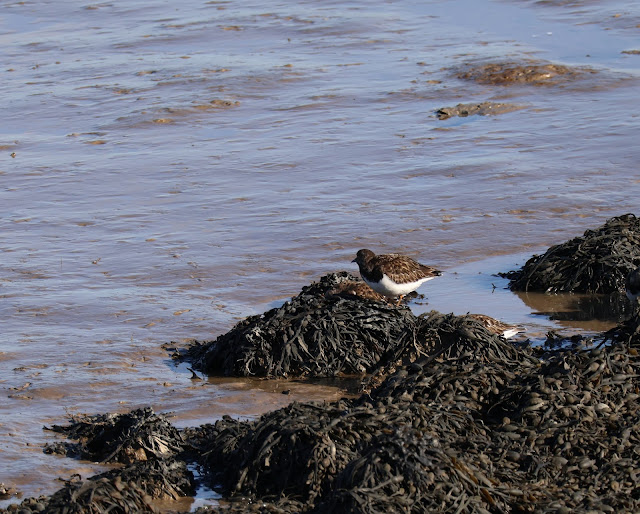A bit of a road trip today, without much in the way of pictures to show for it. I started off early for NT area in Somerset called Brean Downs. It lies between Weston Super Mare and Burnham ion Sea and is a peninsular jutting out beyond a large array of holiday parks which have been built adjacent to the beach. The area I was interested in was some rocks which lie at the northern end of the beach just below a National trust car park. I had read that as well as rock pipits there is an occasional black redstart wintering here and it was these I hoped to find. The tide had been high and was now on its way out, leaving a vast expanse of wet sand. After driving through a rainstorm on the way, the sun was now out and it was turning into a very pleasant morning. The beach was empty apart from the odd dog walker though I knew it would soon become busier. Making my way down to the sand, I proceeded to walk along towards the rocks, looking out for any signs of bird life. It wasn't long before saw and heard some little brown birds - rock pipits - flitting about the rocks ahead of me. As I approached they flew up into the ledges of the sheer rock face above me, and continued their search for food among the crevices. Further along, I found a couple of rock pipits on the rocks on the beach so watched these for a while. I continued along the wet pebbles below the rocks but didn't go too far as I was conscious of the dangers of slipping on wet seaweed. Up above, I suddenly realised there was a whitish shape on one of the grassy ledges. It put its head up and I realised it was a goat! There were about four altogether including one male with some good horns. Sadly I didn't find a black redstart but it was a nice peaceful hour on the beach. As I returned to the car, I found the car park was now considerably busier than when I had arrived, and I decided to leave. I looked towards the peninsular but decided that the steepness of the path and steps would be better left for another day!
Getting back in the car I set my SatNav to a RSPB reserve called Greylakes. It is a small reserve with a short reedbed walk and a couple of hides, fairly close to each other which look over a wetland area. Here were good numbers of ducks, including wigeon and teal, and I also noted a couple of great white egret in the distance. A smaller white bird gave the appearance of a little egret, but I overheard the people next to me saying it was a cattle egret. Not being able to identify it myself, it hasn't made my year list yet.
The rspb carpark and hides were busy and it was hard to find a suitable viewing position amongst the telescopes. The main reason for this was the presence of a Baikal teal, an attractive species of duck which has been at this site since before Christmas. On asking, I was told that it was partly hidden behind some other teal, only visible through a 'scope! However, a kind gentleman did offer to let me look through his scope, which was focussed on the duck. All I could see was its head markings as it was asleep. It was obviously not going to be very obliging like on some previous days. As I scanned the view through my binoculars I suddenly noticed a type of bird of prey flying low over the fields in the distance. I watched it for a while, and then someone mentioned they could see a 'ringtail' ( female hen harrier). I soon realised that was the bird I had been watching though I wasn't in a position to take a photo and it was soon gone.
There wasn't much else to see so I decided to head off. As it was still only lunch time, I realised I would have time to head straight up the M5 to Slimbridge which I did. To cut a long story short, I didn't see the spoonbill, water rail or whooper swan but I did tick off the black tailed godwits which had been missing from my last visit.
Four more year ticks and a pleasant day out in the winter sunshine.



























.JPG)
